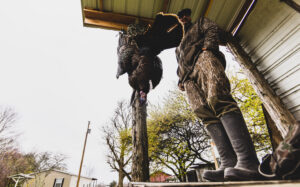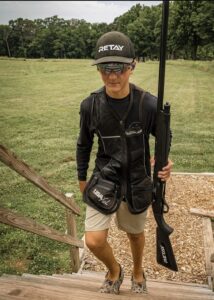
By: Justin Hunold

With today’s purpose driven Turkey Guns, Turkey Chokes and Turkey Shells choices a plenty we are sling patterns tighter than ever. We are able to carry longer, set up better and shoot further. Not only are the guns, chokes and shells better but Turkey hunting is becoming more and more refined.
From basic lead, to plated, duplex, heavier than lead and TSS shot we are sending shots that pattern as tight as baseballs at 25 yards and sometimes even further. Even though most modern turkey guns come with some form of fiber optic sight on them we should be thinking of those as a backup system. If you’ve spent the time, money and effort to get a gun specifically to chase turkeys, that gun should wear a modern optic. What kind of shotgun scope should you use on your turkey gun? Why? Let’s look at shotgun optics choices for turkey hunting.
Why should you run an optic for turkey hunting? The simple answer is precision. When you were out in the field with a simple high brass , heavy game load, full choke and bead you had to know where that gun patterned. This was likely a large pattern by todays standards and you have to keep it in mind everytime you pull the trigger on a Tom.
Now, we are shooting ultra tight patterns out to ranges well beyond sixty yards and we need to know where that shot is going to be. Most patterns are the size of a baseball at twenty five yards with today’s gear, so if you’re off by three to four inches you missed. And who wants to think about where to hold to center the pattern. Sight it in, hold the dot on the spot and press the trigger. The rest takes care of itself. Simple and effective.
Also, when you’re shooting at longer ranges a bead or even rifled sights are likely covering up way more than they should be for you to place those pellets where they have to go. With a scope or red dot you know exactly where your point of aim is. Be sure of your target and beyond, it works a lot better if you are sure where your projectiles will be hitting within reason.
What optic should you have on your Tom tagger? A lot of that is personal preference and hunting style differences. We all have our opinions but there are a few reasons for both a red dot and a LPVO (low power variable optic). Let’s look at them both and help you decide
Red Dots

When we are looking at the first and more popular category of scopes for shotgun we come to Red Dots. There are three types of Red Dots, Reflex, Prismatic, and Holographic. A few years ago I would have said Prismatic sights were the route to go, but more and more reflex sights for shotguns have taken center stage. Holographic sights are great, but tend to be a bit more expensive. Prismatic’s still have a place but for most folks the benefits and price point of a reflex sight is where it’s at in the turkey woods.
Why would you use a reflex sight for a shotgun chasing Tom’s? Adjustable brightness, for when that cloudy spring dawn turns into a sun baked backdrop on an open field, red dot sights for shotguns leave you the ability to quickly adjust the brightness of the reticle. Also weight, a reflex sight is a great lightweight option for those long hikes along oak ridges looking for gobbling birds. Precise, no matter who is behind the reflex sight, no matter what angle the glass is at, no matter what eye dominant or hand dominant position that shooter is in, if the dots on the target it will hit there. Wherever the dot is is where the shot will end up. This isn’t the same for any other sight style other than holographic. This is a real advantage in the turkey woods where non dominant hand shots are somewhat common. Also, take your kid or wife or friend out hunting, hand them your gun knowing that if they put the dot on the spot you have to worry not.
LPVO
A while back you would see a lot of the famous TV hunters putting the smack down on gobblers with Turkey Specific low power variable optics. For a lot of folks there has been zero reason to move away from these. Let’s look at why you want a scope on your turkey gun.
When that Tom hangs up in that open field at 65 yards and you know your TSS is still plenty deadly at that range, you can crank that LPVO up to 4x and place the crosshairs or dot on the waddles, knowing the EXACT placement. What about shooting through that little gap in the brush at his red, white and blue head? Yup, these are the best cases for a scope for turkey hunting.
A fairly new option for LPVO’s that might be an interesting addition to some folks for turkey hunting is an illuminated single dot or reticle in conjunction with the standard reticle available with a lot of these models. Still using a red dot to anchor you to that head poking through the brush, but this time with a bit of magnification, which is right up some hunters alley.
The limiting factors for a more traditional shotgun scope are weight and field of view. Obviously, a variable scope is going to weigh in the range of pounds comparatively to even a tube style prismatic sight which tip the scale in ounces. The other area where a red dot, especially a reflex sight, does a bit better a job on a turkey gun is in the field of view category. The almost non existent ring you will perceive on a reflex sight leaves little to the imagination. Meaning you will see your Tom and everything else going on around him, to make the safest, most accurate, and most ethical shot possible.

Our Turkey Guns come with proprietary bases for mounting optics, and even though we have nice fiber optic beads on the barrel we suggest you use that base to mount the optic of your choice. When running and gunning for turkeys there is a lot left to chance, exact aiming and shot placement shouldn’t be one of them. We do our best to give you every reason to put the best shot on that bird possible, whether that’s with the optic mounted on the included base or a quality fiber optic bead. Let’s be honest we wouldn’t build a base and include it with every Retay Turkey gun if we didn’t think you should be giving a good quality optic a try. Put the dot on the spot and worry not.






